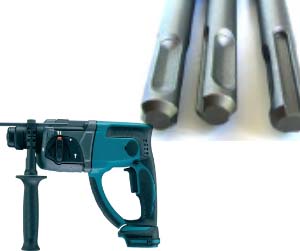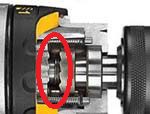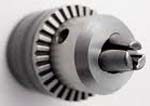Both Hammer and SDS tools are used in masonry applications, each of they has some advantages and own bit type – bits for hammer drills and bits for SDS drills.
Both produce a pounding force that makes them extremely efficient at blasting through masonry. As it spins, the bit chisels away at the masonry. The mechanical process that delivers this pounding action is what separates the two tools.
Rotary Hammer Drills
Hammer drills are lower power devices, have typically a hammering mechanism, in which two sets of toothed gears interact mechanically to hammer while rotating the bit for hammer drill.
As one gear slides past the other, it rises and falls, causing the chuck to slam forward and back. Usually, hammer devices can be used as a regular drill by switching to this action.
They designed for smaller jobs, such as installing pipes or wiring behind walls. If you need to dig through a large wall or into a large section of ground, SDS drill will suit you best.
Usually, hammer tools have self-centering, three-jaw chuck, with capacity of 0.5 in or less and rarely greater than 1, used to hold drill bits or other rotary tools.
You can make a hole or two in a concrete block with a regular drill and a masonry bit, but you’ll want to step it up a notch if you have a whole bunch of holes to drill into 50-year-old concrete.
$50 to $100 hammer tools are good for drilling holes up to 1/2 in. in mortar, block, brick and other light masonry. These drills will also bore into concrete, but slowly. Long time drilling in a tough concrete will overheat motor and chew up teeth in gears. Hammer drills’ advantage is a design for wide range work materials – from stainless steel (with cobalt drill bits) to concrete (with masonry bits).
SDS drills also have drill chuck adapters for any drill bits, but with ones it doesn’t work accurately, adapter isn’t rigidly secured in drill.
SDS Drills
Rotary hammer drills (SDS) are more powerful and have a “hammer-only” mode with no rotation.
An SDS devices is designed slightly differently. They allows you to place a bit in the shaft of the drill. Instead of the bit locking into place (like in a 3-jaw-chuck), it can move slightly. It makes hammering easier.
Rotary hammers usually have an SDS chuck. It has the advantage of fitting into a simple spring-loaded chuck, so that SDS bits are simply pushed into the chuck without tightening.
This shank and chucks made for it are especially suited to hammer drilling with masonry bits in stone and concrete. The drill bit is not held solidly in the chuck, but can slide back and forth like a piston. The hammer of the drill acts to accelerate only the drill bit itself, and not the large mass of the chuck, which makes hammer drilling with an SDS shank drill bit much more productive than with other types of shank.
Rotary hammer drills work with a piston driven by a crankshaft. The piston rides in a cylinder and creates air pressure when driven forward, and it’s the air pressure that actually drives the hammer mechanism.
If you already own a rotary hammer and are looking for a heavy-duty device to bore large holes in wood or mix joint compound, consider buying an SDS-Plus chuck adapter. This adapter will allow you to use smooth-shank drill bits, hole saws and mixing paddles. Just remember to keep the setting on drill mode or you could destroy the chuck.
Rotary hammer drills provide a lot more impact energy than hammer drills. They’re much more durable and are the preferred tool of the pros. Another big advantage is that most rotary hammers have three settings: drill mode, hammer drill or just hammer, so they can act like a mini jackhammer. Of course, they cost more than a hammer drill, but more on that later.






